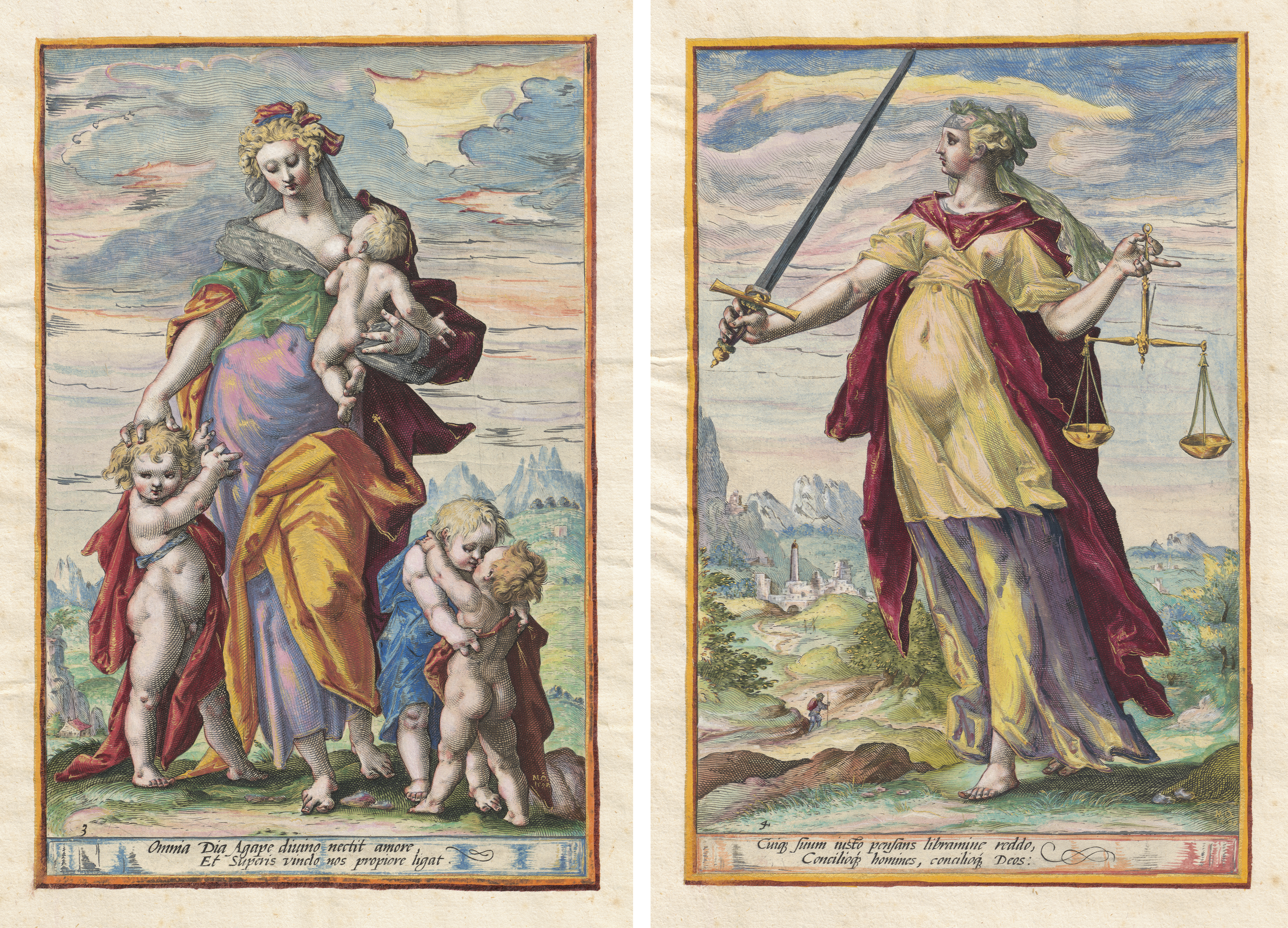Loading the page ...
Jacob Matham
(1571–1631, Haarlem)
and Monogrammist M. Ö. (active in Germany in the late 16th century).
Caritas; Iustitia. Two engravings after Hendrick Goltzius with rich, gold-heightened colouration. Each approx. 22.2 x 14.8 cm. (1597). B. 266, 267; Hollstein 272, 273.
The anonymous colourist M.Ö. illuminated these two engravings from Matham’s series of the Seven Virtues in 1598, just a year after the prints were published in the Netherlands. The short period of time between publication and colouring is a clear indication of the tremendous popularity of reproductive engravings after Goltzius at the time and their widespread distribution. The monogrammist M.Ö., of whom no further biographical details are known, was probably active in Germany or the Habsburg cultural sphere.
Coloured engravings are a hybrid form of art in that they are simultaneously prints and paintings. They were fairly widespread from the 16th century onwards – presumably for the purposes of representation or as exquisite collector’s pieces – although this method of working occasionally proved controversial and was subjected to criticism in certain art theoretical reflections. In his Dialogus Ciceronianus published in 1528, for example, Erasmus of Rotterdam condemned the colouring of engravings in a treatise on Albrecht Dürer. It is unlikely that the vivid colouring of engravings conformed to the working method and aesthetic principles of the Goltzius school, given that Hendrick Goltzius’ engraving style centred on formal plasticity, elegant and vigorous linework and technical virtuosity.
An astonishing feature of both the engravings on offer here is the artist’s use of garish, flamboyant colours. The linear refinement of the black-and-white engraving has been transformed by the intense and highly expressive use of colour. In a demonstration of pride and self-assuredness, the colourist has inserted his monogram and the date 1598 at the bottom right of the image. The colouring ranges from thick, opaque layers of paint for the outer robes of the two allegorical female figures to delicate, diaphanous areas in the background landscape and the sky. The closer one looks, the more captivating the immensely skilful refinement of the colouring becomes. The gold heightening in the figure of Iustitia, in particular, provides ample evidence of the artist’s tremendous ingenuity. Fine stippling enlivens the foliage on the trees, the golden bowls of the scales gleam and sparkle, while the fabric textures of the transparent underskirt and flowing mantle have exquisitely filigree gold heightening woven into them. Certain chords of colour, for instance the juxtaposition of bright orange and lush violet, are reminiscent of the palette of painters of the Rudolfinian School such as Bartholomeus Spranger. We are transported here to the exquisite world of the Kunst- und Wunderkammer, for which it can be assumed that rare collector’s pieces of this kind were produced to meet the needs of a select clientele of connoisseurs.
Three other sheets from the same series coloured by the monogrammist M.Ö. are in the Fogg Art Museum, the Harvard University Art Museums and the Rijksprentenkabinet in Amsterdam respectively (see exhibition catalogue Painted Prints. The Revelation of Color, by Susan Dackerman, The Baltimore Museum of Art and Saint Louis Art Museum, 2002/03, no. 50, pp. 234–238). Both sheets on what is probably a contemporary collector’s mount; the latter slightly foxed. Both engravings are in pristine condition.
Contact us for further information